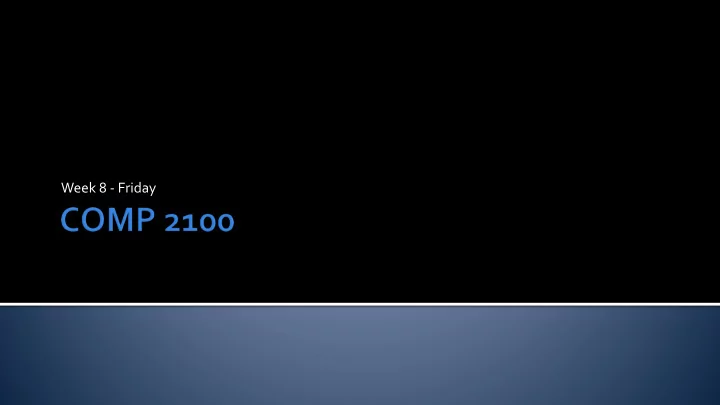

Week 8 - Friday
What did we talk about last time? Balancing trees by construction Hash tables
Infix to Postfix Converter
Wednesdays at 5 p.m. in The Point 113 Already started! Saturdays at noon in The Point 113 Starting this week!
We can define a symbol table ADT with a few essential operations: put(Key key, Value value) ▪ Put the key-value pair into the table get(Key key): ▪ Retrieve the value associated with key delete(Key key) ▪ Remove the value associated with key contains(Key key) ▪ See if the table contains a key isEmpty() size() It's also useful to be able to iterate over all keys
Determine if a string has any duplicate characters Weak! Okay, but do it in O( m ) time where m is the length of the string
What happens when you go to put a value in a bucket and one is already there? There are a couple basic strategies: Open Addressing Chaining Load factor is the number of items divided by the number of buckets 0 is an empty hash table 0.5 is a half full hash table 1 is a completely full hash table
With open addressing, we look for some empty spot in the hash table to put the item There are a few common strategies Linear probing Quadratic probing Double hashing
With linear probing, you add a step size until you reach an empty location or visit the entire hash table 3 19 7 89 104 0 1 2 3 4 5 6 7 8 9 10 11 12 Example: Add 6 with a step size of 5 3 19 7 6 89 104 0 1 2 3 4 5 6 7 8 9 10 11 12
For quadratic probing, use a quadratic function to try new locations: h ( k , i ) = h ( k ) + c 1 i + c 2 i 2 , for i = 0, 1, 2, 3… 3 19 7 89 104 0 1 2 3 4 5 6 7 8 9 10 11 12 Example: Add 6 with c 1 = 0 and c 2 = 1 3 19 7 6 89 104 0 1 2 3 4 5 6 7 8 9 10 11 12
For double hashing, do linear probing, but with a step size dependent on the data: h ( k , i ) = h 1 ( k ) + i ∙ h 2 ( k ), for i = 0, 1, 2, 3… 3 19 7 89 104 0 1 2 3 4 5 6 7 8 9 10 11 12 Example: Add 6 with h 2 ( k ) = ( k mod 7) + 1 6 3 19 7 89 104 0 1 2 3 4 5 6 7 8 9 10 11 12
Open addressing schemes are fast and relatively simple Linear and quadratic probing can have clustering problems One collision means more are likely to happen Double hashing has poor data locality It is impossible to have more items than there are buckets Performance degrades seriously with load factors over 0.7
Make each hash table entry a linked list If you want to insert something at a location, simply insert it into the linked list This is the most common kind of hash table Chaining can behave well even if the load factor is greater than 1 Chaining is sensitive to bad hash functions No advantage if every item is hashed to the same location
Deletion can be a huge problem Easy for chaining Highly non-trivial for linear probing Consider our example with a step size of 5 3 19 7 6 89 104 0 1 2 3 4 5 6 7 8 9 10 11 12 Delete 19 Now see if 6 exists
If you know all the values you are going to see ahead of time, it is possible to create a minimal perfect hash function A minimal perfect hash function will hash every value without collisions and fill your hash table Cichelli’s method and the FHCD algorithm are two ways to do it Both are complex Look them up if you find yourself in this situation
We can define a symbol table ADT with a few essential operations: put(Key key, Value value) ▪ Put the key-value pair into the table get(Key key): ▪ Retrieve the value associated with key delete(Key key) ▪ Remove the value associated with key contains(Key key) ▪ See if the table contains a key isEmpty() size() It's also useful to be able to iterate over all keys
public class HashTable { private int size = 0; private int power = 10; private Node[] table = new Node[1 << power]; private static class Node { public int key; public Object value; public Node next; } … }
Get the number of elements stored in the hash table public int size() Say whether or not the hash table is empty public boolean isEmpty()
It's useful to have a function that finds the appropriate hash value Take the input integer and swap the low order 16 bits and the high order 16 bits (in case the number is small) Square the number Use shifting to get the middle power bits public int hash(int key)
If the hash table contains the given key, return true Otherwise return false public boolean contains(int key)
Return the object with the given key If none found, return null public Object get(int key)
If the load factor is above 0.75, double the capacity of the hash table, rehashing all current elements Then, try to add the given key and value If the key already exists, update its value and return false Otherwise add the new key and value and return true public boolean put(int key, Object value)
Finish implementing hash tables Hash table time trials Map in the JCF HashMap TreeMap Introduction to graphs
Finish Project 2 Start Assignment 4 Get help on Saturday! Keep reading 3.3 Read 4.1
Recommend
More recommend